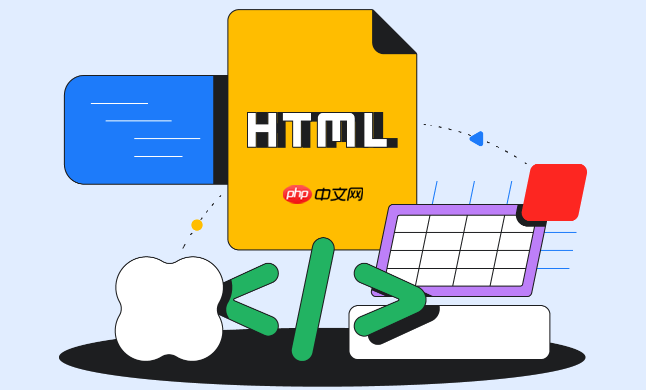瀑布流的实现主要有两种方式:css3和javascript。1.css3通过column-count和column-gap属性实现多栏布局,适用于静态内容,代码简单但控制力弱;2.javascript通过计算每列高度并动态定位图片,灵活可控,适合动态内容。此外,还需处理图片加载失败、实现懒加载(监听滚动事件并加载可视区域内的图片)以及性能优化(如图片压缩、减少dom操作、使用节流函数等)。两种方式可根据实际需求选择使用。

瀑布流,简单说就是参差不齐的多栏布局,图片高度不一,像瀑布一样倾泻而下。关键在于让页面看起来灵动不死板,又能高效利用空间。

直接输出解决方案即可:

要实现瀑布流,核心在于计算每张图片应该放在哪一列,以及如何动态调整这些图片的位置。这里主要介绍两种常见的实现方式:CSS3 和 JavaScript。
立即学习“前端免费学习笔记(深入)”;

CSS3 实现( masonry.js 替代方案)
CSS3 的 column-count 和 column-gap 属性可以快速实现基本的瀑布流,但控制力较弱,可能出现图片排序混乱的情况。
<div class="waterfall">
<img src="image1.jpg" alt="Image 1">
<img src="image2.jpg" alt="Image 2">
<img src="image3.jpg" alt="Image 3">
...
</div>
<style>
.waterfall {
column-count: 3; /* 设置列数 */
column-gap: 10px; /* 设置列间距 */
}
.waterfall img {
width: 100%; /* 图片宽度撑满容器 */
margin-bottom: 10px; /* 图片间距 */
break-inside: avoid; /* 避免图片被分割在两列 */
}
</style>这种方式简单粗暴,但对图片的加载顺序和高度变化不敏感,适合静态内容或者对排序要求不高的场景。break-inside: avoid 是关键,它可以避免图片被截断。
JavaScript 实现(更灵活的控制)
JavaScript 实现的核心思路是:
<div class="waterfall" id="waterfall">
<img src="image1.jpg" alt="Image 1">
<img src="image2.jpg" alt="Image 2">
<img src="image3.jpg" alt="Image 3">
...
</div>
<style>
.waterfall {
position: relative; /* 必须设置 */
}
.waterfall img {
position: absolute; /* 绝对定位 */
width: 200px; /* 固定图片宽度 */
}
</style>
<script>
const waterfall = document.getElementById('waterfall');
const images = waterfall.getElementsByTagName('img');
const imageWidth = 200; // 图片宽度
let columnCount = 0;
let columnHeights = [];
function calculateLayout() {
const containerWidth = waterfall.offsetWidth;
columnCount = Math.floor(containerWidth / imageWidth);
columnHeights = new Array(columnCount).fill(0); // 初始化列高数组
}
function positionImages() {
for (let i = 0; i < images.length; i++) {
let minHeight = Math.min(...columnHeights);
let columnIndex = columnHeights.indexOf(minHeight);
images[i].style.left = columnIndex * imageWidth + 'px';
images[i].style.top = minHeight + 'px';
columnHeights[columnIndex] += images[i].offsetHeight + 10; // 加上图片高度和间距
}
// 设置容器高度,避免塌陷
waterfall.style.height = Math.max(...columnHeights) + 'px';
}
window.onload = function() {
calculateLayout();
positionImages();
}
window.addEventListener('resize', function() {
calculateLayout();
positionImages();
});
</script>这段代码的关键点在于 position: absolute 和 left、top 属性的计算。需要注意的是,图片宽度需要固定,否则计算会变得复杂。 同时,需要处理图片加载完成后的重新布局,可以使用 img.onload 事件。
瀑布流图片加载不出来怎么办?
图片加载不出来,可能是网络问题,也可能是代码逻辑问题。
// 图片加载失败处理
images[i].onerror = function() {
this.src = 'default.jpg'; // 显示默认图片
};瀑布流如何实现懒加载?
懒加载的核心思想是:只加载可视区域内的图片,当图片滚动到可视区域时才加载。
window.onscroll 事件。getBoundingClientRect() 方法获取图片的位置信息。data-src 属性中的图片链接赋值给 src 属性,触发图片加载。<img src="placeholder.gif" alt="Image 1">
<script>
function lazyLoad() {
const images = document.querySelectorAll('img[data-src]');
for (let i = 0; i < images.length; i++) {
if (isInViewport(images[i])) {
images[i].src = images[i].dataset.src;
images[i].removeAttribute('data-src'); // 避免重复加载
}
}
}
function isInViewport(element) {
const rect = element.getBoundingClientRect();
return (
rect.top >= 0 &&
rect.left >= 0 &&
rect.bottom <= (window.innerHeight || document.documentElement.clientHeight) &&
rect.right <= (window.innerWidth || document.documentElement.clientWidth)
);
}
window.addEventListener('scroll', lazyLoad);
window.addEventListener('resize', lazyLoad);
window.addEventListener('load', lazyLoad); // 页面加载完成时执行一次
</script>placeholder.gif 是一张占位图片,可以是一个简单的 loading 图标。 data-src 属性用于存储真实的图片链接。
瀑布流如何优化性能?
瀑布流的性能瓶颈主要在于大量的 DOM 操作和图片加载。
resize 和 scroll 事件的触发频率。transform: translate3d(0, 0, 0),提高动画性能。// 节流函数
function throttle(func, delay) {
let timeoutId;
let lastExecTime = 0;
return function(...args) {
const context = this;
const currentTime = new Date().getTime();
if (!timeoutId) {
if (currentTime - lastExecTime >= delay) {
func.apply(context, args);
lastExecTime = currentTime;
} else {
timeoutId = setTimeout(function() {
func.apply(context, args);
lastExecTime = new Date().getTime();
timeoutId = null;
}, delay - (currentTime - lastExecTime));
}
}
};
}
window.addEventListener('resize', throttle(function() {
calculateLayout();
positionImages();
}, 200)); // 200ms 节流总而言之,瀑布流的实现方式有很多种,选择哪种方式取决于具体的应用场景和需求。CSS3 实现简单快速,但控制力较弱;JavaScript 实现灵活可控,但需要更多的代码和优化。
以上就是html如何制作瀑布流 瀑布流布局设计教程的详细内容,更多请关注php中文网其它相关文章!

每个人都需要一台速度更快、更稳定的 PC。随着时间的推移,垃圾文件、旧注册表数据和不必要的后台进程会占用资源并降低性能。幸运的是,许多工具可以让 Windows 保持平稳运行。




Copyright 2014-2025 https://www.php.cn/ All Rights Reserved | php.cn | 湘ICP备2023035733号